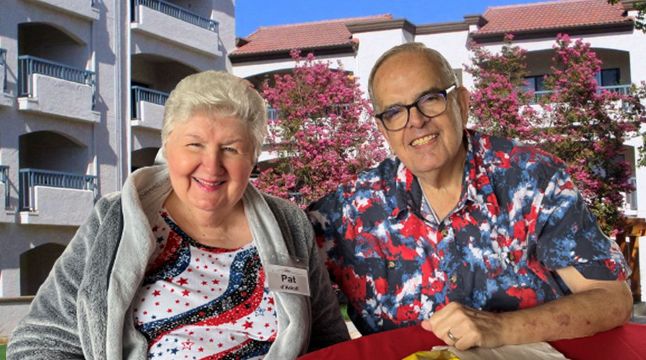What Is Your Retirement Plan?

Have you thought about where you’ll live in your retirement years? It’s an important part of retirement planning, but many people don’t give much thought to their options or how their choices may affect their quality of life as they age. Researching your options early will allow you to make the best decision for yourself and your family, and will give you time to plan for contingencies. Click our downloadable guide to save our tips for planning for your best retirement.
Planning for the What-Ifs
When you picture your life in retirement, what do you see? Perhaps you have plans to travel across the country in an RV or visit destinations around the world. Maybe you see yourself playing golf year-round, relaxing at the beach or joining a pickleball league. You could choose to live near your family so you can watch your grandkids’ sports games and other events. Or maybe you envision a resort-style retirement where your family will love to visit. You owe it to yourself to plan for the future you want. But it’s also wise to consider and plan for what you can’t predict — the what-ifs.
Considering your future needs and putting a plan in place can give you and your family valuable peace of mind and empower you to live your life to the fullest. Let’s consider the two most common options: aging in place at home or moving to a senior living community.
The Costs of Aging in Place
If your first thought is that you’d like to age in place at home, you’re not alone. In its 2021 Home and Community Preferences survey, AARP found that about three-quarters of Americans age 50 and older would prefer to remain in their current residence as long as possible. However, what we want doesn’t always match with reality. Almost half of survey respondents expected they would relocate to a different residence or community, and about one-third acknowledged that their homes would likely need significant modifications to meet their needs as they age.
Financial costs: While there are significant personal advantages to remaining in your home — a familiar environment, emotional attachment and comfort with the surrounding community — the home that served you well in an earlier chapter of your life may not work as well for you in the next chapter. And when you really look at all the costs associated with homeownership and any modifications that may need to be made to accommodate your changing needs, you’ll soon realize that — even without a mortgage payment — aging in place at home is hardly free. Add to that the cost of in-home personal care; assistance with chores like housekeeping, lawn care and meal preparation; and the possibility of eventually having to find skilled nursing care, and you may begin to wonder if staying in your home makes financial sense.
Personal costs: The costs associated with aging in place at home aren’t only financial. Seniors who live alone can also experience social isolation and loneliness. According to the U.S. Department of Health & Human Services’ National Institute on Aging, social isolation and loneliness have been linked to a range of health problems, including an increased risk of dementia, high blood pressure, heart disease, anxiety, depression, and even death. These risks tend to be greater for those who experience a loss of mobility or lack of transportation that inhibits their ability to get out, socialize and engage with their community.
Caregiving takes a toll on family caregivers: The personal costs can also be high for caregivers. Caregivers often balance a job and family along with caregiving responsibilities, which can be physically and emotionally exhausting. Caregivers tend to experience higher levels of stress and negative emotions like sadness, anger and frustration. According to the American Psychological Association, while many family caregivers report psychological satisfaction and growth in caring for a loved one, they also report emotional distress and experience higher levels of depression and physical health problems than their non-caregiving peers. Clearly, while the caregiver may consider it an act of love and service, it can exact a toll.
The financial cost to caregivers is concerning as well. The MetLife Study of Caregiving Costs to Working Caregivers, published by the MetLife Mature Market Institute, found that the average aggregate of lost wages, pension, and Social Security benefits for working caregivers caring for an aging parent is more than $300,000.
Benefits of Moving to a Senior Living Community
Today’s senior living communities are designed to empower you to live as independently as possible. The maintenance-free lifestyle rids you of the chores and hassles of home maintenance, yardwork, housekeeping and cooking — which means you’ll have more time to do the things you truly enjoy. You’ll also find services and amenities such as social, recreational, and educational events; daytrips to places like museums and theaters; transportation to medical appointments and shopping centers; fitness centers with group exercise classes and personal training; multiple dining options; and so much more. And you’ll never be alone unless you want to be. There’s always something to do and someone to do it with.
On the financial side, a significant advantage of senior living communities is that a single monthly payment typically covers not only your residence and all maintenance, but also utilities and almost all the services and amenities the community offers — including your meals. You can create a more predictable financial future for yourself without worrying about juggling the burden and expenses of homeownership and rising health care costs.
Finding Certainty in Uncertain Times
Many seniors are rethinking their retirement plans as they face strong headwinds due to financial market fluctuations and economic factors beyond our control. Although it’s impossible to predict the future, you have the power to choose how you want to plan for it. If you’ve built equity in your home over the years, you can use that to fund your future. Think about it as investing your home equity into the future you want and the lifestyle you deserve.
Life Plan Communities (also known as Continuing Care Retirement Communities or CCRCs) help you protect your financial future by providing a full continuum of health care services. Many communities offer independent living along with higher levels of care such as assisted living, memory care, short-term rehabilitation and skilled nursing care — all conveniently located on one campus. And if you choose a Type A Continuing Care Plan, your monthly payment is likely to stay essentially the same, no matter what level of care you need. This can represent a huge savings over paying for an assisted living or skilled nursing facility on a direct-admit basis or paying for in-home skilled nursing care.
The advantages can be even greater for couples who move into independent living. If one partner eventually needs a higher level of care, he or she will be able to receive care while remaining on the same campus and paying essentially the same monthly fee they paid in independent living.
Envision Your Future at Casa de las Campanas
As you consider your retirement housing strategy, make sure a visit to Casa de las Campanas is part of your research. Casa is the only Type A not-for-profit Life Plan Community in the San Diego area. It’s a beautiful destination where you’ll find spacious residences and pricing options to fit your budget. Discover a vibrant and carefree lifestyle, security, and priceless peace of mind for you and your family members — all within a predictable financial framework. Schedule a personal visit today and see this community for yourself. To learn more about senior living in San Diego, check out our upcoming events.
Download this guide to learn more.





